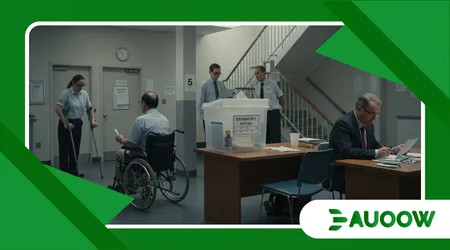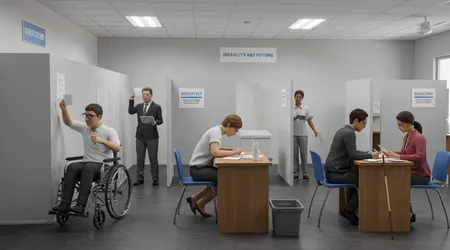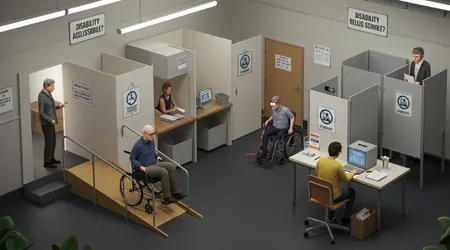Disability and Voting: Are Polling Stations Really Accessible?

Disability and voting are intertwined in the fight for democratic inclusion, yet many polling stations remain inaccessible, undermining equal participation.
In 2025, as digital and physical barriers persist, the right to vote for people with disabilities is often more theoretical than practical.
Despite legal protections like the Americans with Disabilities Act (ADA) and the Voting Accessibility for the Elderly and Handicapped Act (VAEHA), systemic gaps leave millions struggling to exercise their civic rights.
This article explores the state of voting accessibility, dissecting physical, technological, and policy-related challenges while proposing actionable solutions.
Why should anyone’s voice be silenced by a ramp that isn’t there or a ballot they can’t read?
The stakes are high. According to a 2020 Election Disability and Voting Accessibility Survey, 11% of disabled voters faced barriers when casting ballots, nearly double the rate of nondisabled voters.
From inaccessible polling locations to outdated voting machines, the obstacles are varied and persistent.
This piece delves into the realities of disability and voting, offering insights into legal frameworks, practical examples, and the urgent need for reform to ensure every citizen’s voice is heard.
The Legal Landscape: Rights on Paper, Gaps in Practice
The ADA, enacted in 1990, mandates accessible polling places, yet compliance is inconsistent. The Voting Rights Act of 1965 allows disabled voters to choose assistance, but enforcement varies.
The Help America Vote Act (HAVA) requires at least one accessible voting system per polling site. Despite these laws, many facilities fall short, leaving voters with disabilities sidelined.
A 2021 Government Accountability Office report found 60-70% of polling locations had accessibility issues, like missing ramps or narrow doorways.
++ Why Digital Accessibility Should Be a Legal Standard, Not an Option
These barriers disproportionately affect those with mobility or visual impairments. Legal protections exist, but without consistent enforcement, they’re hollow promises for many.
The National Voter Registration Act (NVRA) mandates voter registration assistance at disability service offices, yet compliance is spotty.
Some states fail to provide accessible registration materials, further limiting participation. Laws are only as strong as their implementation, and here, the system falters.

Physical Barriers: When Access Stops at the Door
Imagine arriving at a polling station in a wheelchair, only to find a steep staircase blocking entry. This isn’t hypothetical it’s a reality for many.
Physical barriers like uneven pathways, heavy doors, or inaccessible parking persist across the U.S. These issues turn civic participation into an obstacle course.
For example, in rural Georgia, a voter named Sarah, who uses a wheelchair, had to vote from her car in 2020 because the polling site lacked a ramp.
Such makeshift solutions compromise privacy and dignity. Polling places in schools or churches often predate modern accessibility standards, exacerbating the problem.
Also read: How Budget Cuts Are Affecting Disability Services in 2025
Temporary fixes, like portable ramps, are often inadequate or missing. The Department of Justice’s ADA Checklist for Polling Places offers solutions, but many jurisdictions ignore it.
Without consistent audits, physical inaccessibility remains a stubborn barrier to disability and voting.
Technological Hurdles: Voting Systems That Exclude
Voting technology should empower, not exclude. Yet, many machines lack features for visually or mobility-impaired voters.
Touchscreens without audio output or tactile interfaces frustrate those needing accommodations. Disability and voting intersect critically here, as outdated systems undermine independence.
In 2020, voters with visual impairments reported difficulties with ballot-marking devices lacking screen readers.
Modernizing equipment is costly, and budget constraints often delay upgrades. States like California have invested in accessible machines, but adoption is uneven nationwide.
Read more: How Disability Laws Differ Across Europe: A Country-by-Country Breakdown
Digital voter registration websites also pose challenges. Many lack compatibility with assistive technologies, violating ADA standards.
For instance, a 2024 audit found 30% of state voter portals failed WCAG 2.2 accessibility guidelines, leaving disabled users stranded. Technology must evolve to include everyone.
Policy Failures: Anti-Voter Measures and Their Impact
Anti-voting policies, like strict ID requirements or mail-in ballot restrictions, disproportionately harm disabled voters.
These measures, often targeting marginalized groups, amplify barriers for those with disabilities. Disability and voting face a double burden when policies ignore accessibility needs.
For example, signature-matching rules for mail-in ballots can exclude voters with motor impairments unable to sign consistently.
In 2020, 51% of disabled voters used mail-in ballots, yet many faced rejections due to technicalities. Policymakers must address these inequities.
Guardianship laws also strip voting rights from some with intellectual disabilities, despite federal protections.
States like Ohio have reformed these laws, but others lag. Policy reform is critical to ensure voting access for all.
The Intersection of Disability and Marginalized Identities
Disability doesn’t exist in isolation. Black and Indigenous voters with disabilities face compounded barriers from polling place closures in their communities.
One in four Black Americans has a disability, making these policies doubly discriminatory. Disability and voting must be viewed through an intersectional lens.
For instance, in Arizona, Native American voters with mobility issues struggled with long travel distances to polling sites in 2020.
These closures, often justified by budget cuts, systematically suppress marginalized voices. Accessibility must account for these overlapping challenges.
Advocacy groups like the AAPD emphasize that candidates prioritizing disability rights are crucial.
Voters with disabilities deserve policies that reflect their diverse identities and needs. Intersectionality isn’t optional it’s essential for equity.
Innovative Solutions: Paving the Way for Inclusion
Solutions exist, but implementation lags. Crowdsourcing low-cost accessibility fixes, like tactile ballot guides, can empower voters with visual impairments.
Disability and voting benefit when creativity meets commitment. States like Oregon lead with accessible vote-by-mail systems.
Consider Maria, a blind voter in Oregon, who used a tactile ballot guide in 2024 to vote independently.
Such tools are affordable and effective but underutilized. Local officials must prioritize these innovations to close accessibility gaps.
Training poll workers is another key step. Programs like Florida’s PAVA educate staff on assisting disabled voters, ensuring dignity and access.
Scaling these efforts nationwide could transform disability and voting outcomes.
The Role of Advocacy and Community Action

Grassroots advocacy drives change. Organizations like the National Disability Rights Network push for enforceable accessibility standards.
Their 2023 report highlighted inconsistent state compliance with federal voting laws. Disability and voting thrive when communities demand accountability.
Local action matters too. In Michigan, disability advocates partnered with election officials to audit polling sites, identifying barriers like missing signage.
These collaborations bridge gaps between policy and practice, amplifying disabled voters’ voices.
Voters can engage by asking local officials about accessibility plans.
Questions like, “What percentage of your polling sites are fully accessible?” spark accountability. Community-driven change ensures disability and voting are prioritized.
Global Perspectives: Learning from International Efforts
Accessibility isn’t just a U.S. issue. The European Accessibility Act, effective June 2025, mandates digital inclusivity, including voter registration platforms.
This global push offers lessons for improving disability and voting in the U.S.
Germany’s Accessibility Strengthening Act ensures digital platforms meet WCAG 2.1 standards, benefiting 7.8 million disabled citizens.
The U.S. could adopt similar rigorous standards for voting systems. International models highlight the power of enforceable regulations.
India’s 2025 Supreme Court ruling declared digital access a fundamental right under Article 21, pushing for inclusive e-governance.
This precedent could inspire U.S. courts to strengthen voting accessibility mandates. Global insights fuel local progress.
Accessibility of Polling Places: 2020 Data
| Barrier Type | Percentage of Polling Places Affected |
|---|---|
| No accessible parking | 25% |
| Missing ramps | 40% |
| Narrow doorways | 15% |
| Inaccessible voting booths | 20% |
A Call to Action: Building a Truly Accessible Democracy
Ensuring disability and voting are synonymous with inclusion requires urgent action. Policymakers must enforce existing laws and fund accessible technology.
Communities should advocate for audits and training to eliminate barriers. Every vote counts, and every voter deserves access.
Think of voting as a bridge to democracy when it’s broken, entire communities are stranded.
In 2025, 11% of disabled voters still face barriers, a statistic that demands change. By prioritizing accessibility, we build a democracy where no one is left behind.
This isn’t just about ramps or machines; it’s about dignity, equity, and the right to be heard.
Election officials, advocates, and voters must unite to dismantle barriers. The time for half-measures is over full accessibility is non-negotiable.
Frequently Asked Questions
Q: What are the main barriers to voting for people with disabilities?
A: Physical barriers like inaccessible polling sites, outdated voting machines, and restrictive policies like signature-matching rules disproportionately affect disabled voters.
Q: How can I help improve voting accessibility in my community?
A: Contact local election officials, ask about accessibility audits, and support advocacy groups like the AAPD or National Disability Rights Network.
Q: Are mail-in ballots a solution for disabled voters?
A: They help, but issues like signature requirements or inaccessible forms can still exclude voters with motor or visual impairments.
Q: What laws protect voting rights for people with disabilities?
A: The ADA, Voting Rights Act, HAVA, and NVRA mandate accessibility, but inconsistent enforcement often undermines their impact.
